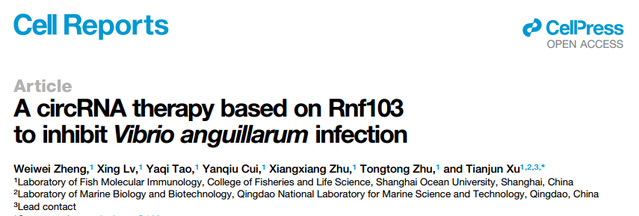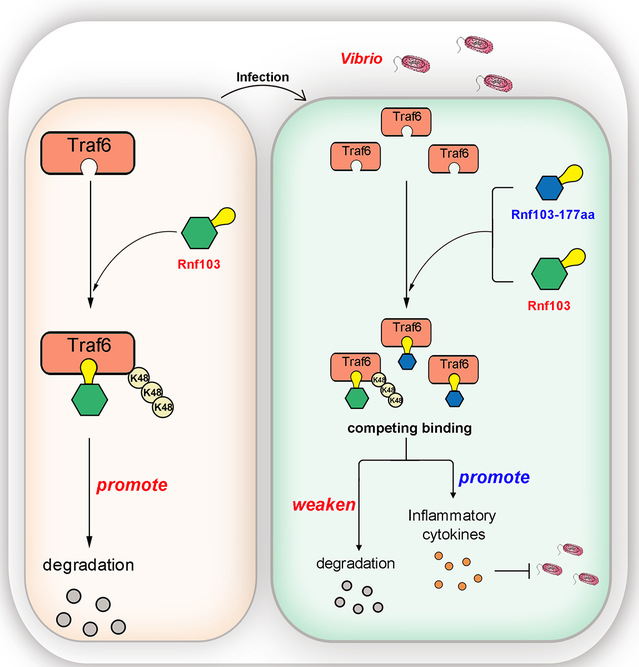Recently, Professor Xu Tianjun’s Team at SHOU has made new progress in research on the treatment of Vibrio anguillarum infection in fish with a circRNA therapy. The research results have been published in Cell Reports, a sub-journal of Cell, titled “A circRNA therapy based on Rnf103 to inhibit Vibrio anguillarum infection”. Zheng Weiwei, a Doctoral candidate of SHOU, is the first author of the paper, and Professor Xu Tianjun is the corresponding author.

mRNA vaccines emerged as a new force during the COVID-19 pandemics. Differing from traditional vaccines, they achieve efficient immunization in vivo by adopting RNA delivery for the first time. The “pioneers” of the mRNA vaccine technology have shared the 2023 Nobel Prize in Physiology or Medicine for this achievement. It is foreseeable that the mRNA technology will show great potential in tumor vaccines, infectious disease vaccines, protein replacement therapy, immunotherapy, and rare disease treatment. However, notwithstanding its advanced concept, the mRNA technology still has the inherent defect of poor mRNA stability and requires numerous additional RNA modifications. As a result, mRNA vaccines face challenges such as harsh storage and transport conditions and significant side effects. In this context, the brand-new circRNA technology precisely points out the way to overcome these challenges. Compared with mRNA, circRNA is characterized by high stability and low immunogenicity, without requiring numerous additional RNA modifications, so it is also referred to as “mRNA Technology 2.0”. Many pharmaceutical R&D giants have focused on the circRNA technology and the circRNA therapy. In 2022, a team from Peking University reported a circRNA vaccine against SARS-CoV-2 in Cell, which has produced desirable effects.
Fulminant vibriosis, one of the most serious diseases threatening aquaculture, can lead to the death of a large number of infected fish, shrimp, and shellfish, causing huge losses to the aquaculture industry every year. So far, there is a lack of effective prevention and control strategies, except for antibiotics. In the context of antibiotic abuse and antibiotic phobia, it is particularly important to seek more effective prevention and control strategies.
In this paper, the research group has discovered a protein called E3 ubiquitin ligase Rnf103 (Rnf103) which plays a key role in the immune escape of Vibrio anguillarum in fish, and a circRNA molecule called circRnf103 that can effectively inhibit the immune escape of Vibrio anguillarum. Relying on these findings, the team has developed a circRnf103 nucleic acid molecule using the circRNA vaccine technology. The circRNA therapy based on the circRnf103 nucleic acid molecule can effectively treat Vibrio anguillarum infection and alleviate damage to various organs. This study elucidates the molecular mechanism by which circRNA enhances the natural immunity of fish, and demonstrates that the circRNA immunotherapy presents broad application prospects in the prevention and control of fish diseases.

Molecularmechanism by which circRNA regulates the immune escape of Vibrio anguillarumin fish